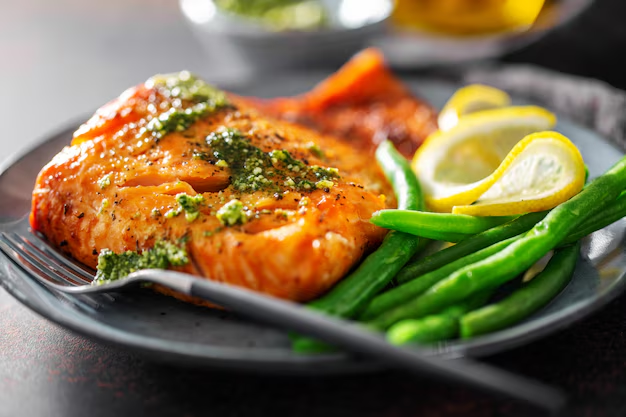How Long Can You Safely Store Cooked Salmon in the Refrigerator?
There's nothing like a delicious serving of salmon, rich in flavor and nutrients. But what happens when there's enough leftover to save for later? Knowing how long you can keep cooked salmon in the refrigerator is essential for maintaining food safety and enjoying the best flavors. Let’s dive into not only the storage duration but also how to maximize your salmon's shelf life and maintain its quality.
🐟 Understanding Salmon’s Shelf Life: Why It Matters
Cooked salmon is a versatile dish loved for its health benefits and delectable taste. However, like all seafood, it has a finite shelf life. Proper understanding of this aspect is critical for several reasons:
- Food Safety: Consuming spoiled seafood can lead to foodborne illnesses, with symptoms ranging from mild discomfort to severe reactions.
- Economical: Ensuring leftovers don't go to waste saves money.
- Optimal Taste and Texture: Consuming salmon within its ideal window maintains its delicious flavor and satisfying texture.
⏳ How Long Does Cooked Salmon Last in the Refrigerator?
Cooked salmon lasts in the refrigerator for 3 to 4 days. This time frame ensures safety and that the salmon’s flavor and texture remain at their peak. To be more precise:
- Day 1: The salmon is still fresh, maintaining its full flavor and excellent texture.
- Day 3: The salmon begins to lose some flavor and texture.
- Day 4: The last optimal day for consumption without risk of spoilage.
🗓️ Quick Storage Tips:
- Refrigerate promptly: Place salmon in the fridge within two hours post-cooking.
- Use airtight packaging: Seal the salmon in airtight containers or wrap it tightly in aluminum foil.
- Set refrigerator temperature: Ensure your fridge is at or below 40°F (4°C).
🧊 Can You Freeze Cooked Salmon for Longer Storage?
Yes! Freezing is an excellent option if you need to store cooked salmon for more than a couple of days. When properly frozen, cooked salmon can last for 2 to 3 months.
📦 Freezing Guide:
- Cool Before Freezing: Allow the salmon to cool to room temperature before freezing to prevent ice crystals.
- Wrap Effectively: Double-wrap the salmon using both plastic wrap and aluminum foil, or use vacuum-sealed bags to prevent freezer burn.
- Label Clearly: Mark the date on the package so you remember when it was frozen.
🕵️♂️ Detecting Spoiled Salmon: Signs to Watch For
While the time guidelines are useful, it's crucial to know the signs of spoilage. Always check for:
- Strange Odor: A strong, sour, or ammonia-like smell indicates spoilage.
- Discoloration: Any dullness or off-color might suggest that the salmon has gone bad.
- Slimy Texture: A slippery film on the surface is a red flag.
🚫 Safety First!
If you notice any of these signs, it’s best to throw away the salmon. Consuming spoiled seafood can be harmful.
🍽️ Creative Ways to Use Leftover Salmon
If you have leftover cooked salmon, there are plenty of ways to transform it into another tasty meal:
- Salmon Salads: Flake salmon and toss with mixed greens, cherry tomatoes, and a vinaigrette.
- Salmon Patties: Mix with breadcrumbs, an egg, and herbs, then pan-fry.
- Salmon Tacos: Use flaked salmon as a filling with avocado, lime, and salsa.
- Pasta Dishes: Stir into cooked pasta with cream sauce and spinach.
🔒 Proper Salmon Storage: Your Key to Safety and Quality
Here’s a quick summary to keep your salmon storage safe and effective:
- Refrigerator Storage: 3-4 days at or below 40°F (4°C).
- Freezer Storage: 2-3 months with appropriate wrapping.
- Inspect before eating: Always check for signs of spoilage.
- Use leftovers creatively: Turn leftovers into delightful new meals.
📝 Practical Storage Summary: 🎣
| Step | Action | Emoji Reminder |
|---|---|---|
| Post-Cooking | Refrigerate within 2 hours | ⏲️ |
| Refrigeration Temp | Keep at or below 40°F (4°C) | 🌡️ |
| Packaging | Use airtight containers/aluminum foil | 📦 |
| Storage Duration | Consume within 3-4 days | 📅 |
| Freezing | Double wrap and label—use within 2-3 months | ❄️ |
| Check for Spoilage | Odd smell, color changes, or sliminess = discard | 🚫 |
Being mindful of how you store and prepare cooked salmon can heighten both your enjoyment and safety. By understanding these guidelines, you ensure that each bite is as satisfying as the first, while also taking a practical approach to food preservation.
Whether you're preparing a salmon dinner for tonight or storing leftovers for the days ahead, these strategies guide you toward sustaining both taste and nutrition, prolonging the enjoyment of this delightful dish.
